Who is Paolo Maldini?
Few players can boast the longevity to have matched up against both Maradona and Cristiano Ronaldo.
In fact, only one player comes to mind.
His name is Paolo Maldini.
Though he played in a different era, Il Capitano’s brilliance on the pitch leaves us with timeless lessons in defending.
This tactical analysis is part retro scouting report, part tactical theory.
We’ll explore the core principles that made Maldini the defender he was, highlighting those characteristics for a contemporary audience.
By the end, we’ll have concrete ideas to take with us to the training ground, either as coaches or players.
Before progressing to the article, know that Maldini is the only highlighted player in this analysis.
When you see a player with a circle underneath him, that’s our guy.
Further, since these are classic matches, the picture clarity it’s not at the level of current matches.
That said, I’ve chosen games that generally have a higher picture resolution and wide tactical view.
No Maldini vs Maradona in the analysis, unfortunately.
Much better to watch that one on video than see the battle through still images.
Paolo Maldini Tackling & physicality
This seems like an old starting point for a man who, according to The Sun’s analysis, only averaged 0.56 challenges per game during his storied 25-year career, but starting with his tackling and physicality will give us a sense of the player, the warrior, he was.
Maldini famously said, “If I have to make a tackle, then I’ve already made a mistake.” Let’s start with his mistakes.
Watch any Maldini highlight reel, and you’ll find a ferocious defender who flew into sliding tackles.
A buddy of mine used to start every game in Maldini mode, which meant he laid out an opponent with a strong tackle.
For anyone who has not watched much football from the ’90s and early 2000s, getting stuck in and sliding into bone-crushing tackles was the norm.
Though the officiating has tightened up to eliminate some of the more career-threatening challenges, there are still fundamental principles we can learn from Maldini’s tackles.
To really get a glimpse of the Italian at his best, my research consisted of matches against Europe’s top clubs in pivotal games.
Up first, we have Maldini vs Luis Figo and the Galacticos of Real Madrid.
Transitioning from a second defender to a first defender role, Maldini identified the limited space available to Figo.
Quickly applying pressure to the Portuguese winger, Maldini influenced the timing of Figo’s action.
This is the first key to defending, making the where and the when predictable.
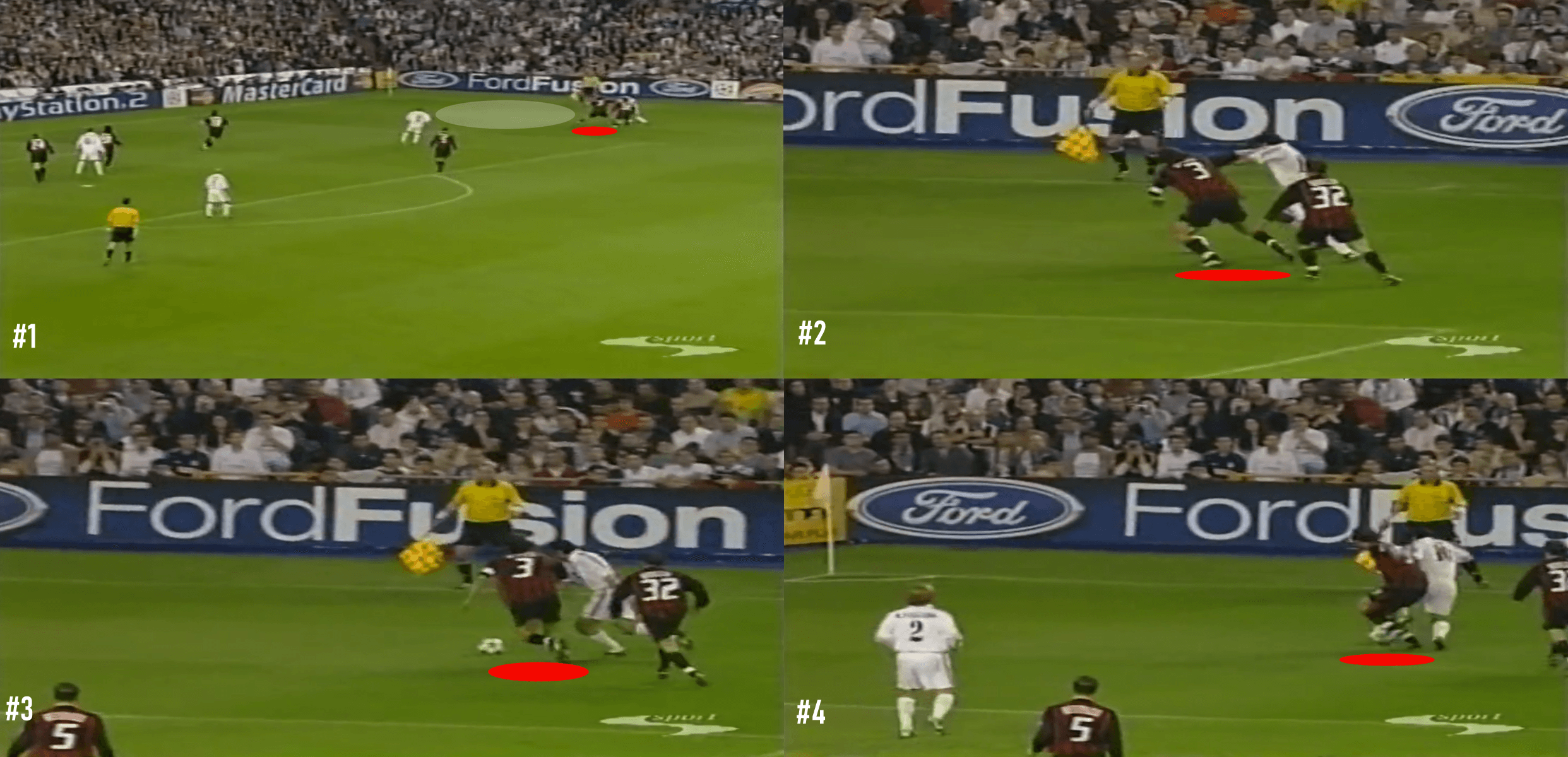
Knowing where Figo was going and influencing the ‘when’, Maldini showed excellent quickness in his response and did well to use his right hand and arm to make contact with his opponent.
Leading with the arm is pivotal.
Firstly, it helps the defender maintain his balance.
Secondly, well-directed contact will put the attacking player off his balance.
Thirdly, it allows the defender to outpace the attacker during those first two or three steps.
Finally, the defender can use that space to slide his interior shoulder inside the attacker, sealing him from the ball and establishing body position.
Understanding when to go into a tackle was one of Maldini’s key strengths.
He was always looking for visual cues to signal his actions.
If a player took a bad touch, put their head down, or turned their back to him, Maldini went in strong for the recovery.
That last point is exactly what you see in our second image.
Figo turned his back to Maldini, so the Italian committed to the tackle and was able to poke the ball away with a lunge between Figo’s legs.
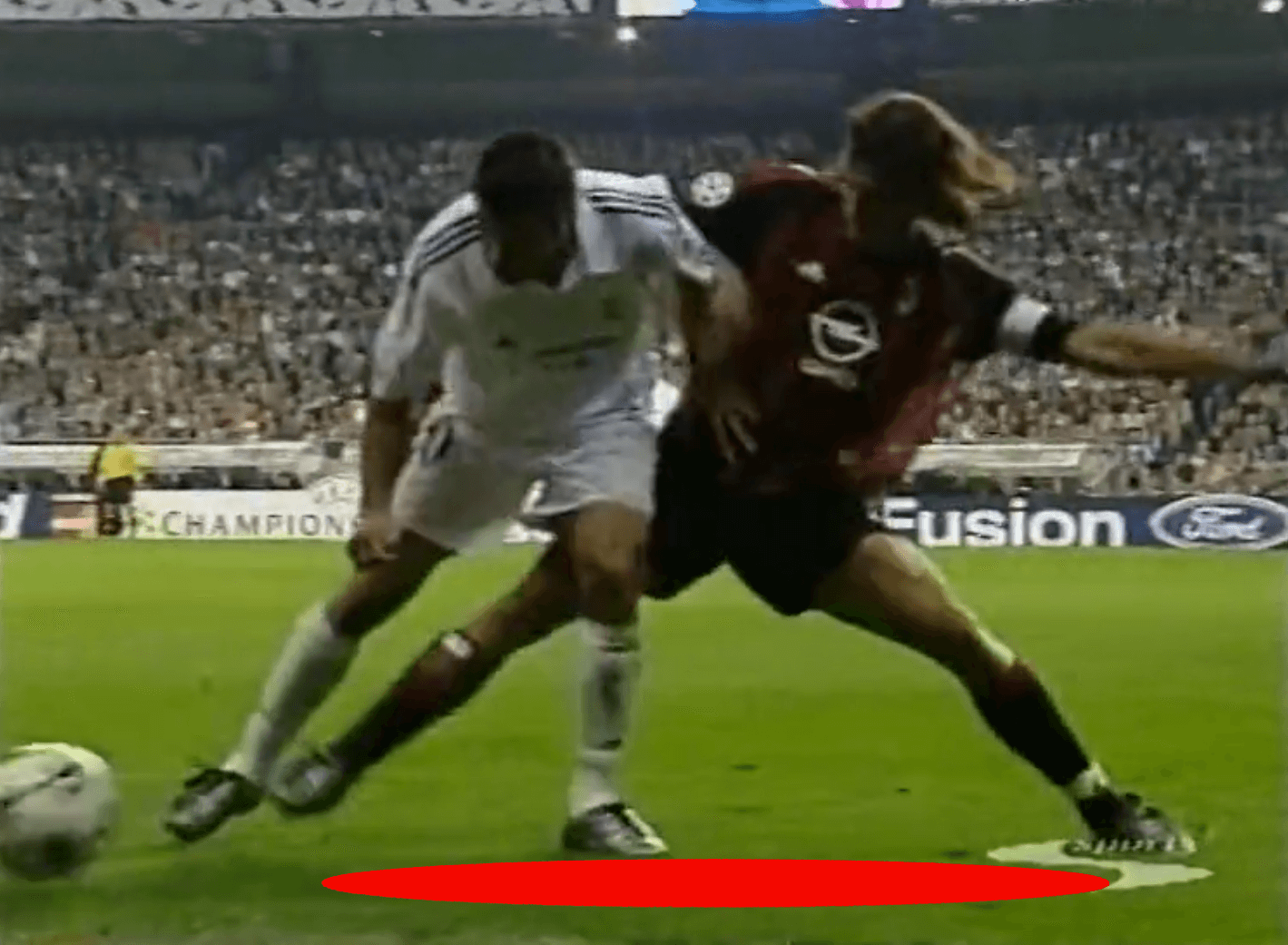
As you watch Maldini play, his tackling technique and approach impress.
Though he was certainly known for his flying, sliding tackles, he was always in complete control.
Two of the keys to his tackling ability were the starting positioning and approach.
We’ll focus more on the approach in this section.
Looking at our next four in one image, we see that Maldini initially starts the play in the left half-space.
Note that he’s playing as a left-back in this match against Ajax.
His objective was to remain tightly connected to Franco Baresi and deny central penetration.
Once Ajax passed the ball to the wings, Maldini was quick to close the space between himself and his opponent.
As Maldini approaches, he does well to decelerate and prepare for the 1v1 duel.
However, his opponent pops the ball up with his first touch, cueing Maldini to go in for the tackle.
In the third part of that sequence, Maldini lunges in with a sliding challenge.
He doesn’t get the ball, but his opponent gets a poor touch to knock the ball away from the Italian, which ends up in AC Milan’s hands anyway.
Though he doesn’t win the tackle, his action forced a turnover.
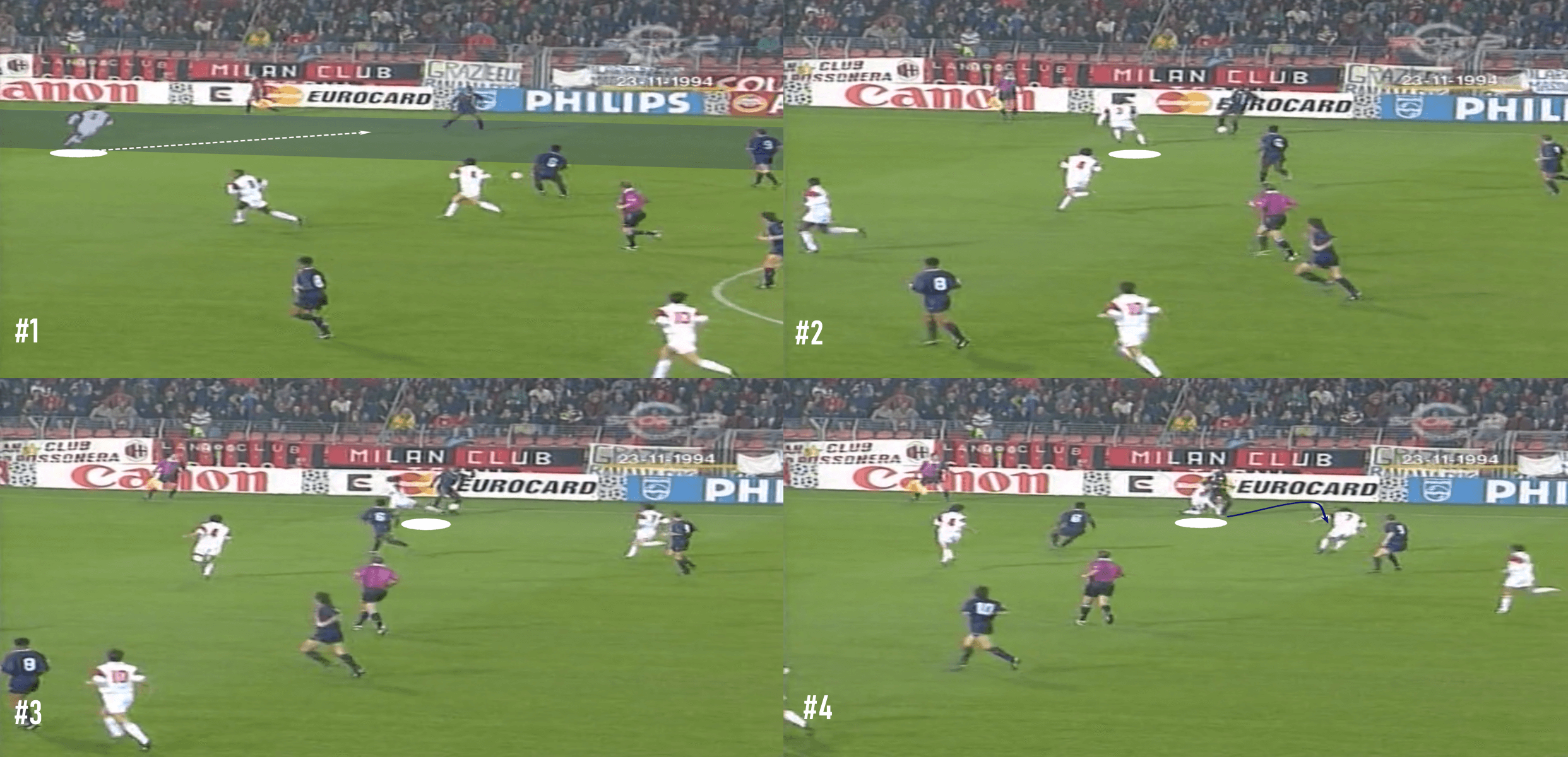
One of the keys to Maldini’s success was his early read of future actions.
His anticipatory skills were phenomenal.
Key observations include his ability to identify runners as they started their move, understand the vulnerabilities he needed to defend against and read the body mechanics and eyes of players on the ball.
Those qualities were incredibly helpful in tackles and his approach, but they were equally effective in allowing him to cover space behind the backline.
The man was rarely beaten with balls played behind.
What’s more incredible is that he was rarely beaten despite his very average speed.
Awareness and early preventative actions generally put him two or three steps ahead of the opponent.
Taking our final sequence in the section, we have a pass that was played behind Maldini.
Initially, he had a two-step advantage over his opponent, but that advantage disappeared as they neared the ball.
Even though the remaining meters were hotly contested, the limited ground to cover and close proximity to the attacker allowed Maldini to turn the sprint into a physical duel.
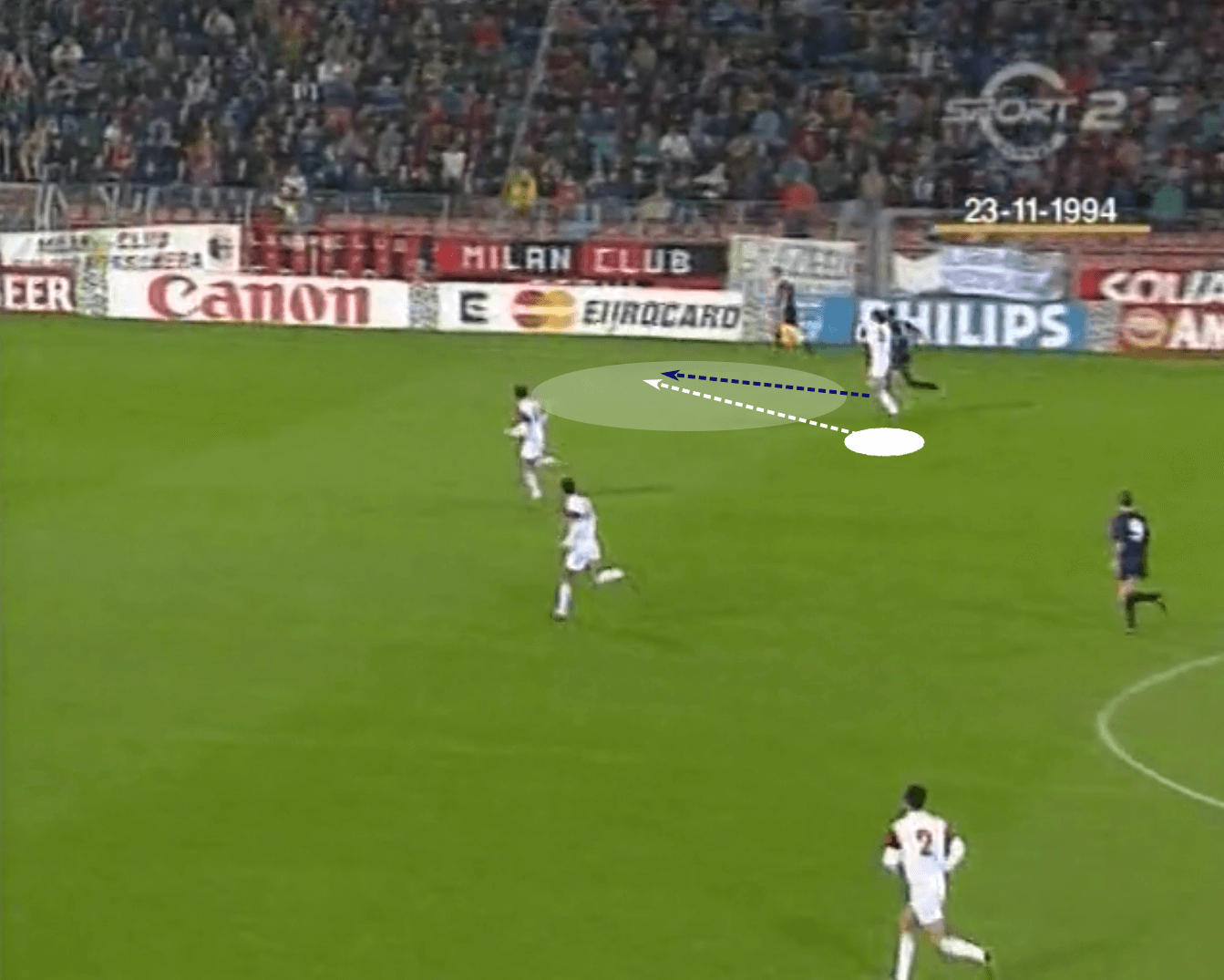
Again, we see the use of the arms and upper body throughout the sequence.
The interior arm and hand are used to delay his opponent’s progress, and then he’s able to slide his right shoulder between the opponent and the ball.
Having established body position, his opponent, Ajax’s George Finidi, could only clip his opponent and commit the foul.
A master class in neutralizing pace through physicality.
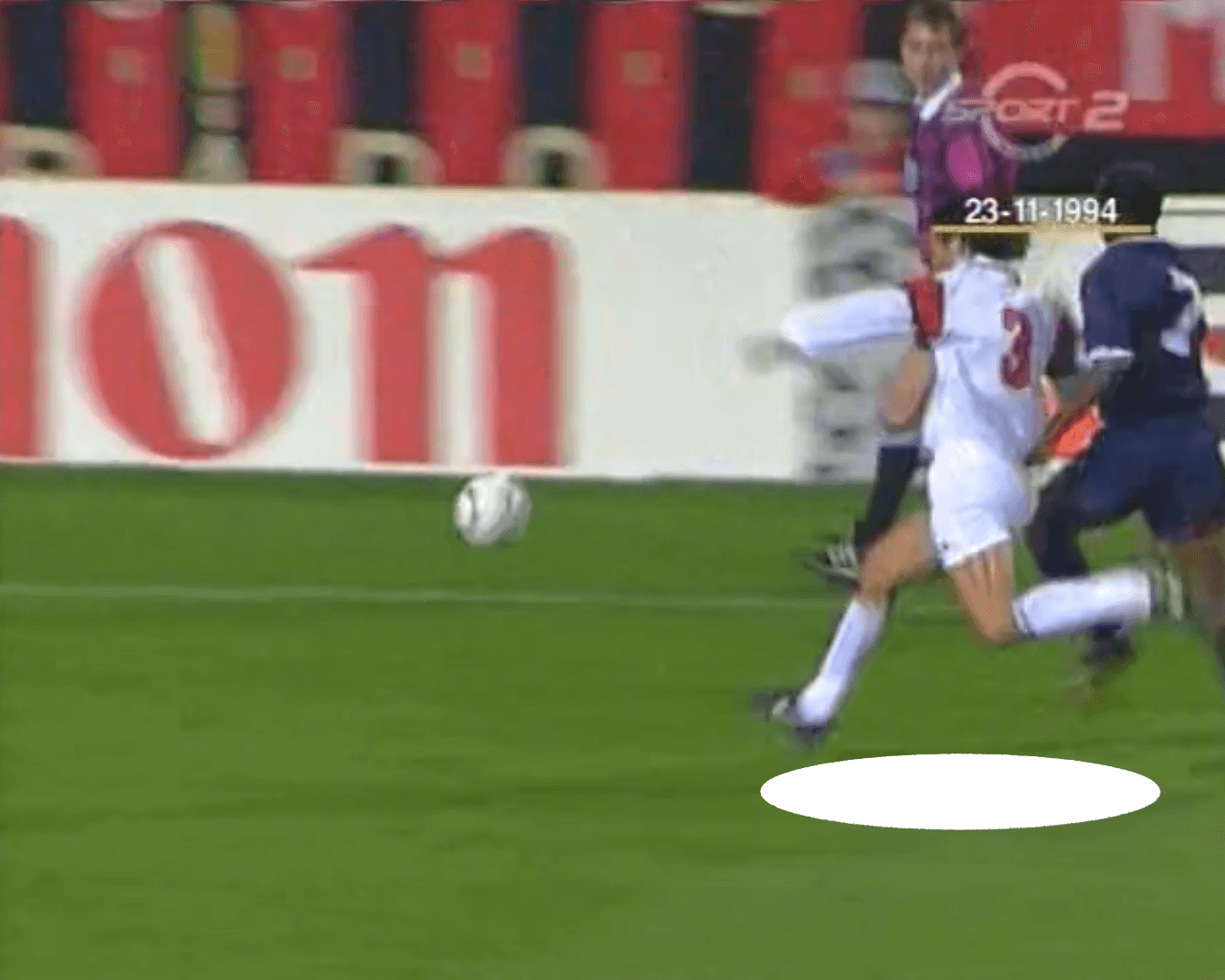
In each of these instances, the opponents were unprepared for action.
Most of the time, they were in a physical state of unbalance.
When you break down 1v1 duels, Maldini maintains his own balance while negatively impacting that of his opponent is typically the one with the advantage.
In that sense, 1v1s are a battle of balance.
By limiting movement solutions, Maldini routinely reduced his duels to physical battles, allowing him to knock his opponent off balance and then establish positioning to win the duel.
Maldini wasn’t the fastest player, nor was he the quickest, but his ability to influence the timing of actions and respond at the earliest possible moment was a clear differentiator.
Add his excellent use of high contact to slow the opposition and establish a body position and you can understand why he’s considered an all-time great.
Paolo Maldini Positioning
When researching this article, one idea that stood out repeatedly was that Maldini habitually defended from a position of strength.
What do I mean there?
When defending, teams are best prepared when they have made play predictable and can funnel opponents into pressing traps.
Within those pressing traps, there are a few, if any, outlets.
The idea is to force the opponent to play into preferred areas of the pitch and then engage with some form of superiority, such as numeric, positional, or qualitative, as we see in Maldini’s case.
When Maldini was called into action, he typically engaged in a way that limited his opponents’ options.
Often, the Italian did well to bait them into a 1v1 duel, which typically favoured Maldini, or to play non-threatening passes backward.
Predictability is contingent upon the limited options available to the attacker.
Positional awareness and angles of approach, primarily when held in relation to teammates in support, are limiters that work against attacking players.
Let’s see it in action.
Our first sequence in the section is represented by the three-in-one image.
After a switch of play, Maldini takes a more conservative approach, remaining in a deeper position while he allows his nearby midfielder to recover ground and move into a first-defender role.
With pressure on the ball, Maldini took up the second defender responsibilities.
When he saw Figo prepared to make his move, Maldini stepped into action.
Here’s the beauty of the sequence.
Dribbling into the wing was Figo’s best option.
That’s where the space was and he was fighting off an opponent on his interior shoulder.
Movement to the inside was further complicated by the presence of Maldini.
Notice that Maldini’s positioning is directly in front of Figo.
Rather than allowing Figo to use his pace to the outside, possibly running the Milan defenders into each other, Maldini is essentially forcing him inside.
Based on Maldini’s body orientation, you get the impression he is showing Figo wide, but this excellent use of defensive deception is clear as Figo makes his move.
Contact on the Portuguese’s left and Maldini’s swift turn to block Figo’s path results in an easy win for the Italian.
Barreise slid over from his third defender position for an unopposed recovery.
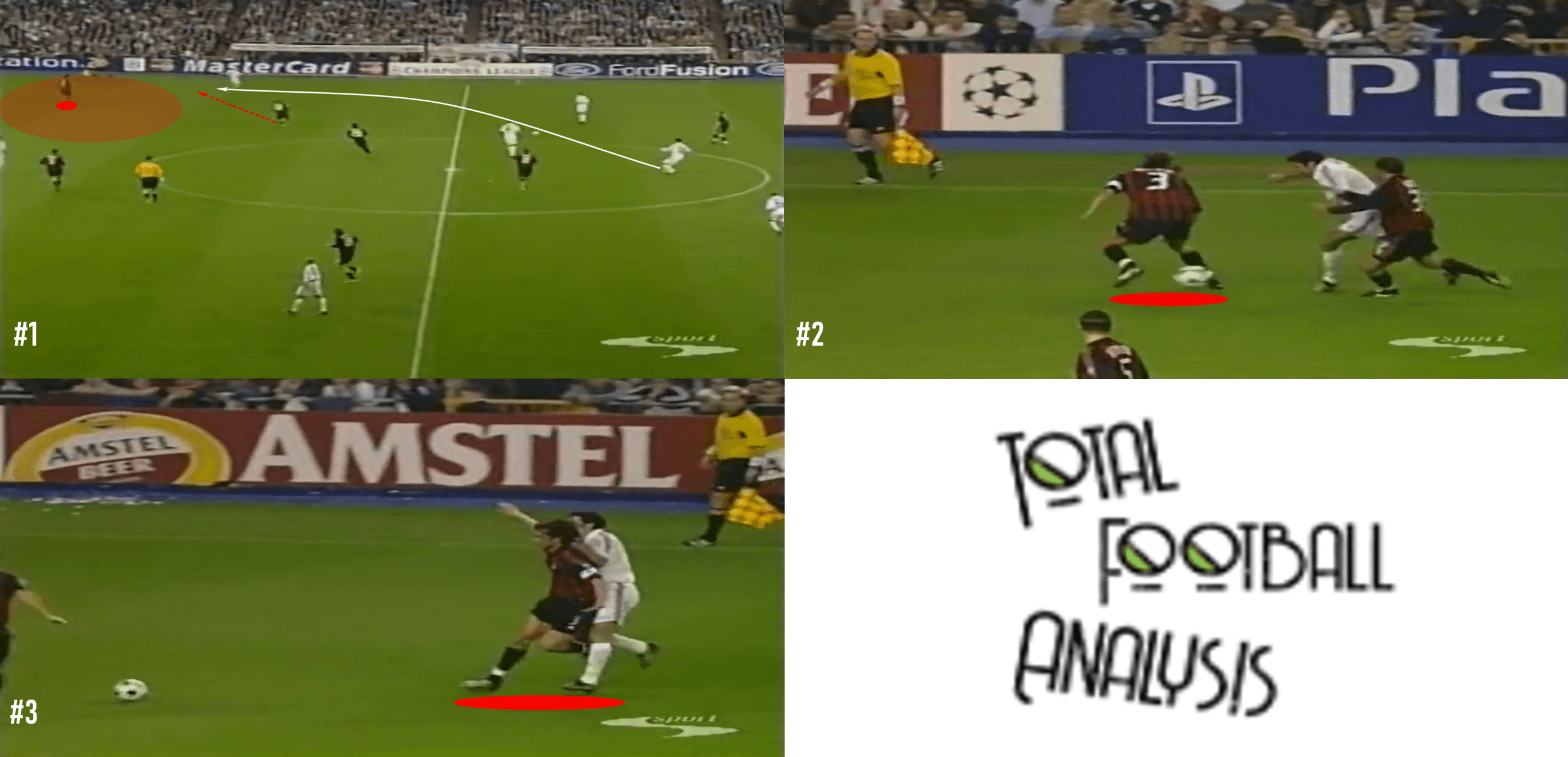
Despite his average pace, El Capitano’s mind was always much faster than his opponents.
In addition to seeing play develop moments before his opponents did, Maldini also showed his excellent understanding of his physical abilities through his positional orientation.
He knew that if opponents received either in front of or wide of him, then he could turn the duel into a physical encounter, which favoured him.
The space he protected most fervently was the one behind the backline.
Whether protecting against his own lack of pace or covering for his teammates along the backline, Maldini was always prepared to recover into that space.
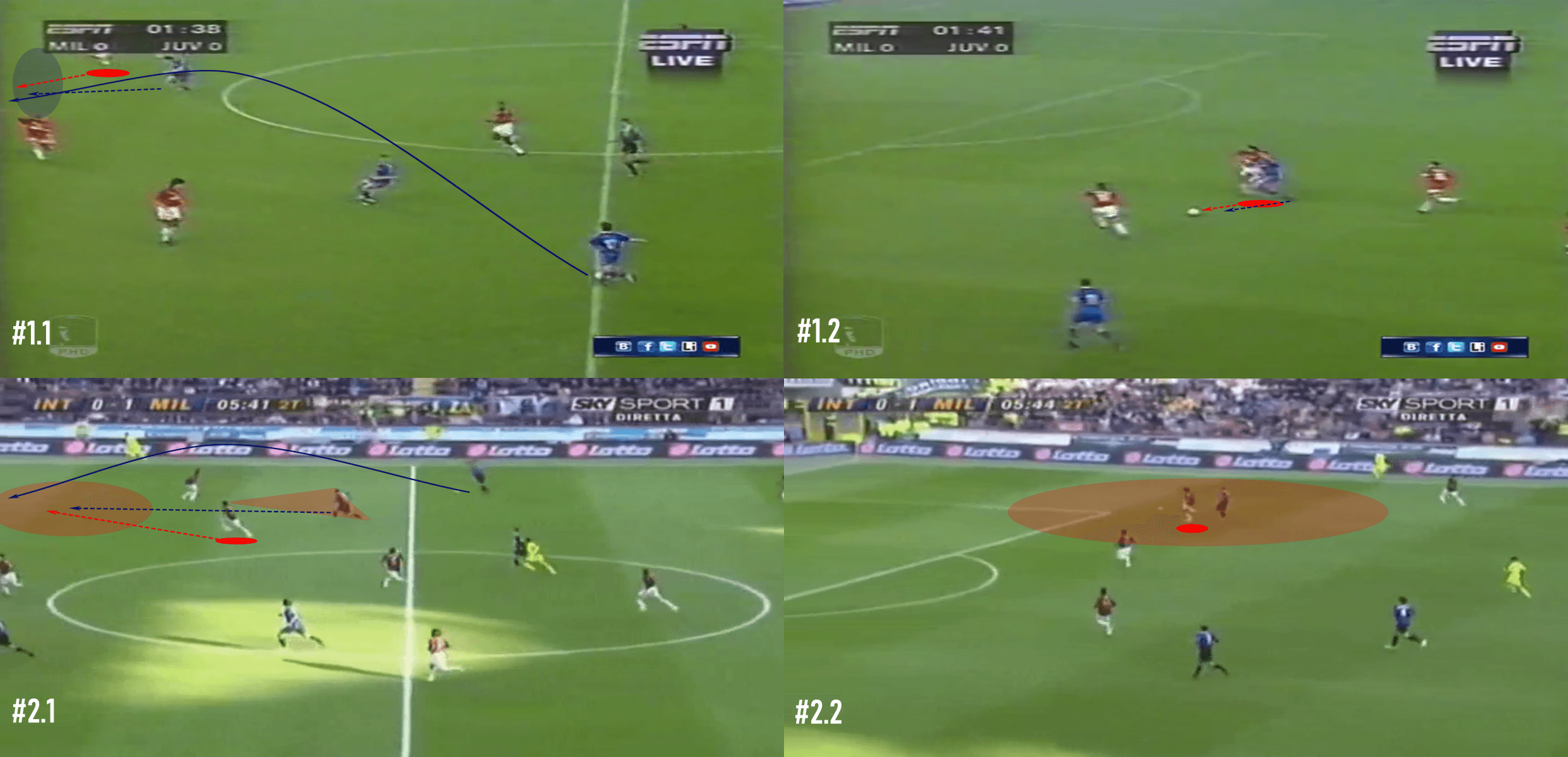
Our four-in-one image gives two scenarios of him protecting that space.
The top two images show him covering for his centre-back against Juventus.
As they prepare to play the ball over the top, you can see Maldini already running back to cover that space.
With a 5 meter head start, he beat his opponent to the ball despite the disadvantage in pace.
The two images on the bottom capture a sequence following a Milan corner kick.
As Maldini returns to his positional responsibilities, he identifies the early run of his opponent.
Rather than waiting for confirmation that the ball is going long, he’s off to the races.
It was another scenario where his opponent had a significant pace advantage, but Maldini’s awareness of the run and early response to cover the worst-case scenario led to a recovery.
I suppose the underlying theme in this section is awareness.
To defend from a position of strength, you have to understand which options are on the table and how you can influence your opponent’s decision-making.
Once the opponent commits, that cues the defender into action.
In more open space, body orientation and frequent scanning are the means of tracking an opponent.
As space becomes more condensed, especially in or near the box, the best way to maintain awareness of your opponent’s positioning is through contact.
Our final single frame image of the section shows Maldini using that principle in action.
As Inter Milan prepared to cross the ball into the box, Maldini took up a goalside position, making interior arm contact with his opponent.
Though his opponent was ball near, giving him some access to the cross, Maldini’s contact and goal side positioning gave him the advantage on any balls delivered to the near post.
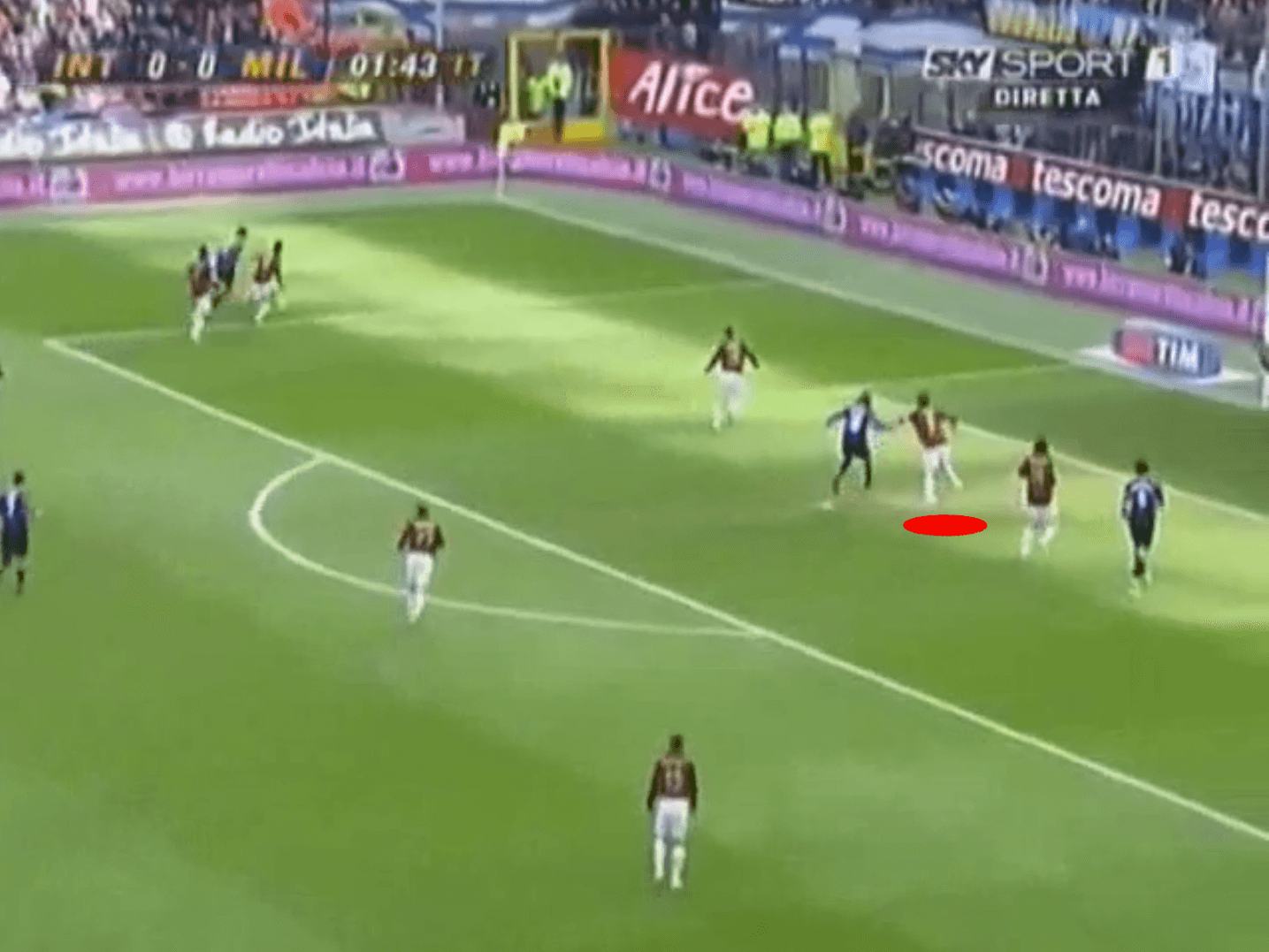
Let’s see the progression of awareness actions.
In the final four-in-one image of the section, the first graphic shows Maldini with excellent body orientation that allows him to scan for threatening movements of his opponents while also watching the activity near the ball.
#2 is highlighted by Inter Milan’s attacking progression.
They are now looking to cross the ball, as Maldini quickly scans his back shoulder and identifies his opponent.
In #3, he tracks his runner deep into the box and adjusts his body orientation for improved vision, finishing the sequence in #4 with full contact and goal-side positioning on his opponent.
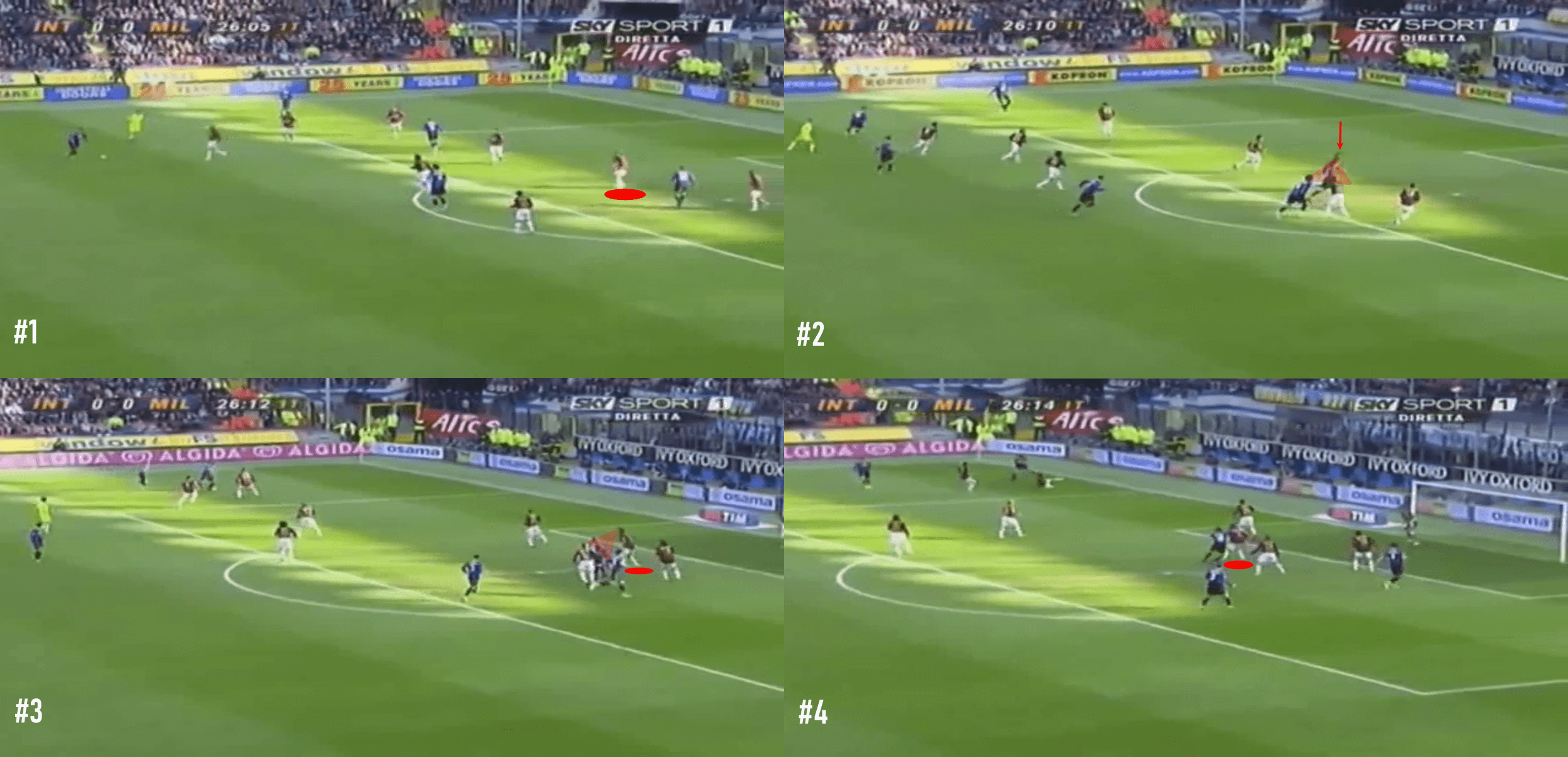
Defending from a position of strength is ideal, but it takes a lot of work before being called into action.
Eliminating vulnerabilities, funnelling play, and understanding all available options are the guiding principles.
It wasn’t enough for Maldini to engage and use his superior tackling to end plays.
He wanted to engage his opponent while eliminating as many variables as possible.
The level of hyper-awareness necessary to consistently defend from a position of strength was one of Maldini’s top traits.
Limiting the opponent’s options simplified his decision-making and allowed him to focus on cues for action.
Less (options for the opponent) is more (streamlined decisions for the defender).
Paolo Maldini Anticipation
This third section is a little bit different from the others.
We’ve already addressed anticipation in the two previous sections, but only as a secondary idea.
Piggybacking on the principle of awareness from the previous section, we’ll progress to identifying specific visual cues Maldini searched for and how that allowed him to act decisively and lead his teammates.
First, before we proceed, one of Maldini’s best traits is that he was a true leader.
Vocal and directive, his read of play and understanding of how he and each of his teammates fit into that dynamic was key to his impact.
He’s the kind of player who was able to pan out and see the bigger picture then communicate clear and concise ideas to his teammates.
Rather than focusing simply on himself, he made everyone around him better.
Center backs must use their deep positioning and expansive field view to constantly scan for threats and shift teammates into the right positions.
Through vocalizations and hand gestures, they can improve the positioning of their teammates and the outcomes of sequences.
Maldini, as is shown in the first image of this section, was constantly directing his teammates.
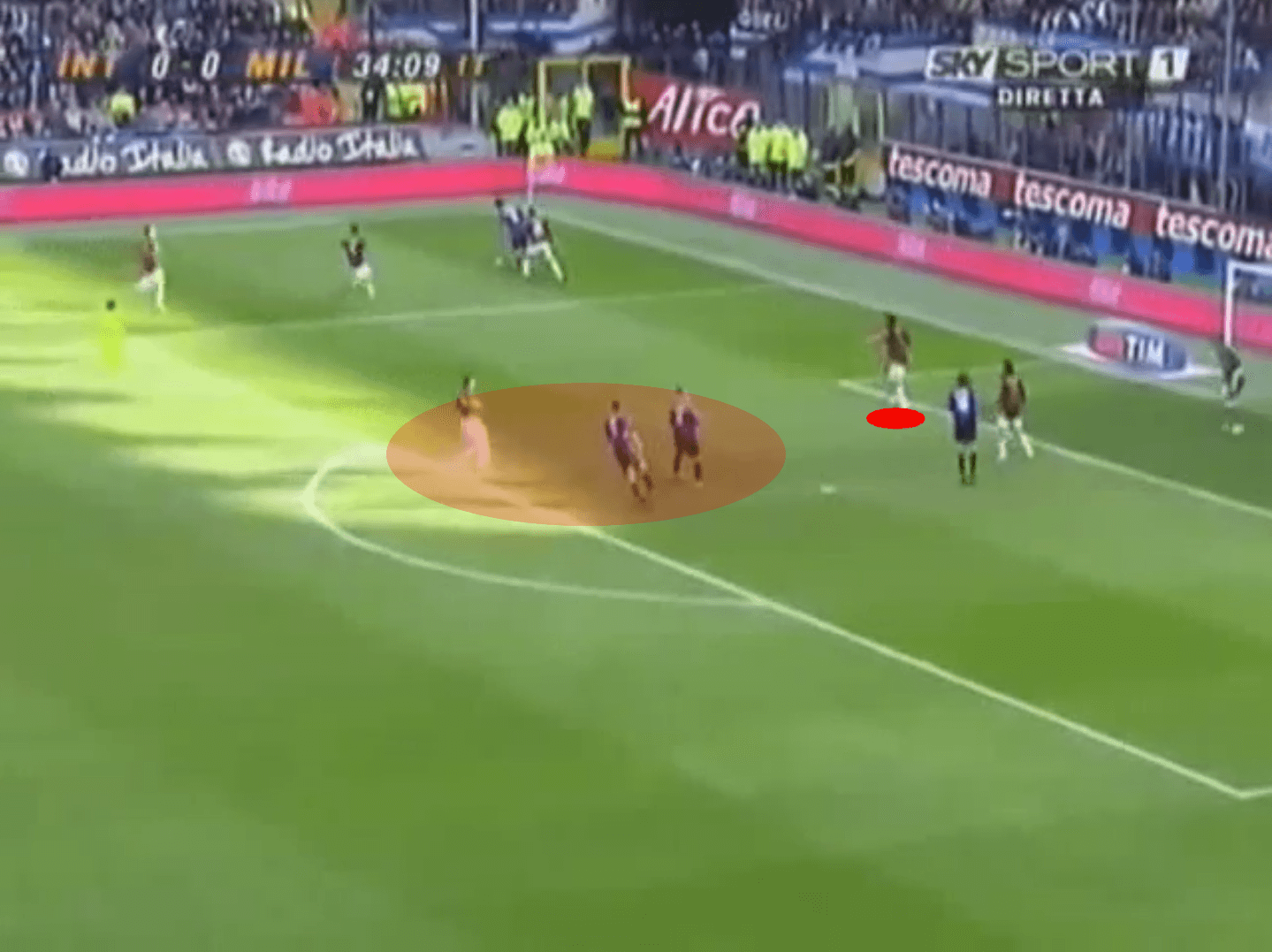
It’s one thing to direct, but another to know what information to communicate to your teammates.
In the case of Maldini, his reading of the game, especially his understanding of threats and vulnerabilities and how to counter those dangers, was inherent to his impact.
So what was he looking for and how did he respond? Let’s look at a few ideas.
Returning to AC Milan’s Champions League fixture against the Real Madrid Galacticos, we have an instance of the La Liga side in an attacking transition and Milan caught out of position.
Maldini took a quick note of the 1v1 behind him, the 1v1 in the wing, and the free player centrally.
The first action was clear; recover into a position of strength to limit the greatest threats.
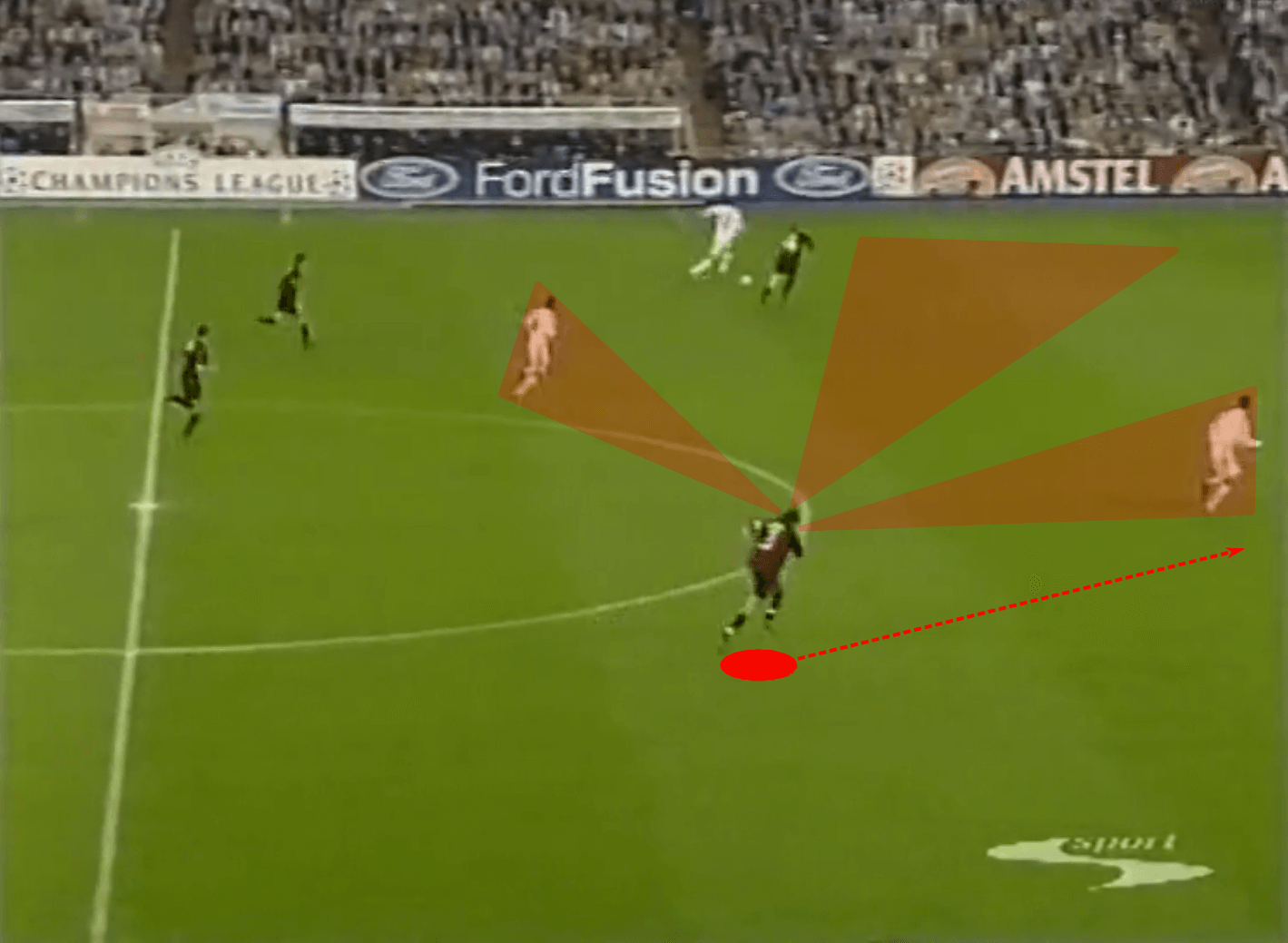
Maldini made an excellent recovery into the box, giving AC Milan a 2v1 centrally.
As Real Madrid looked to send the cross, Il Capitano was in a position to continue with the runner while also watching the first attacker’s eyes and body mechanics.
Once the ball carrier made eye contact with the trailing runner and started to square his hips for the pass, Maldini broke his stride and quickly moved upfield to intercept the pass.
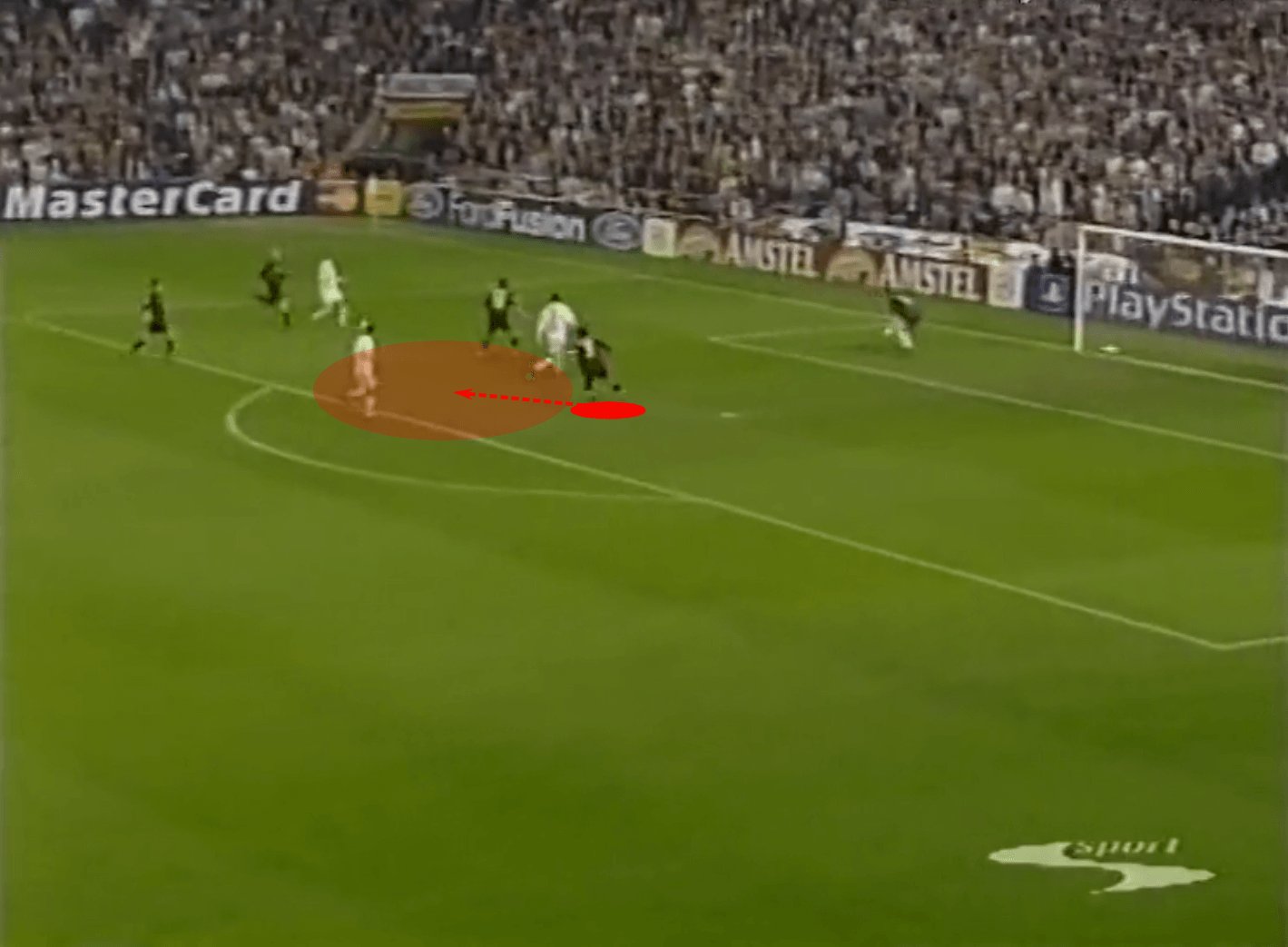
While the other six field players were still running towards the Milan goal, Maldini ran onto the pass for an easy interception.
One key here is that Maldini quickly recovered to a position of strength, positioning himself to contest as he passed into the path of the player closest to goal.
By recovering that basic positioning, he eliminated the need for a chaotic recovery and shot block.
Instead, his deeper positioning allowed him to slow the pace of his backtracking, identify the trailing runner, and anticipate the negative cross.
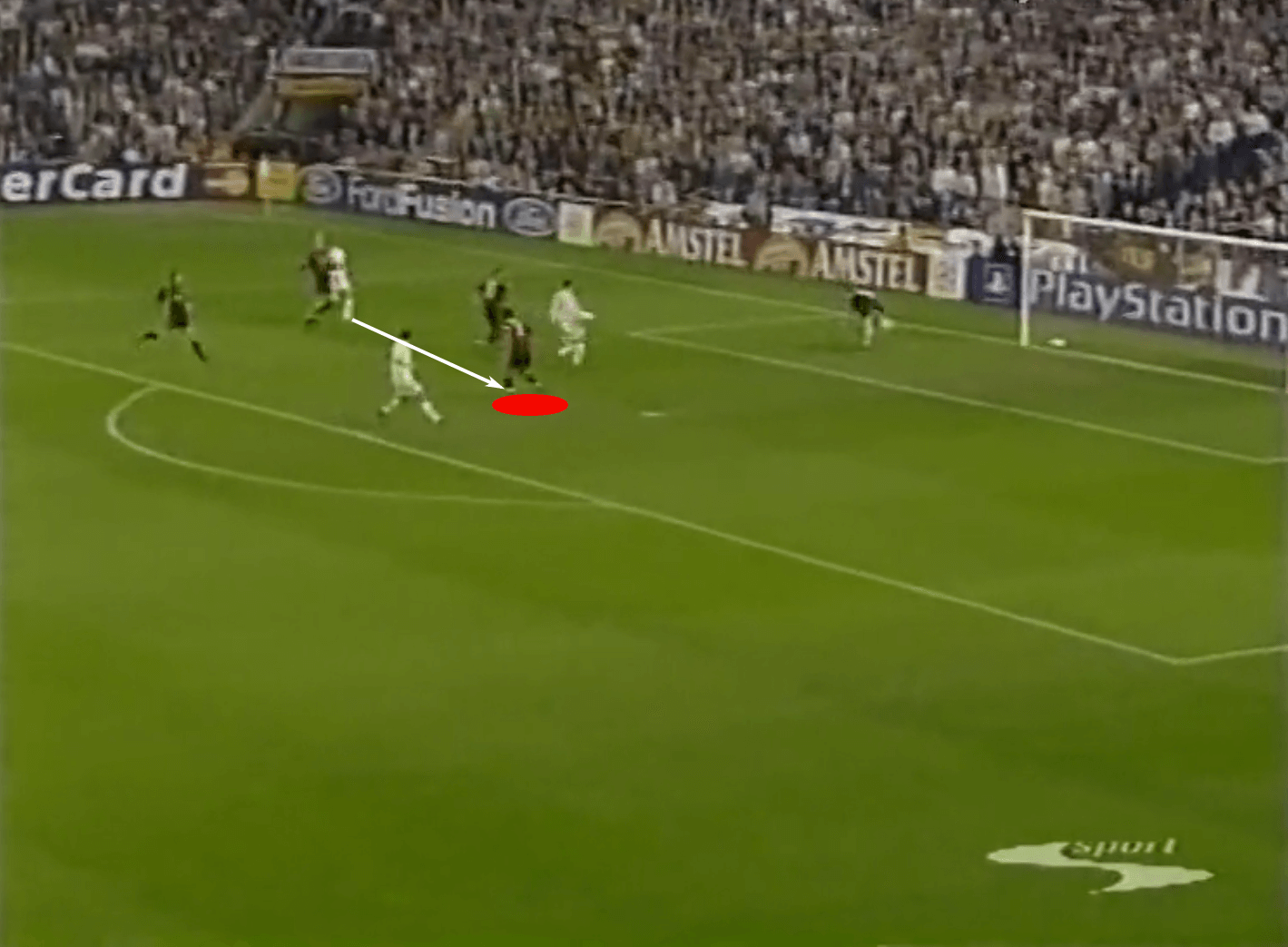
Milan’s highly organized approach limited the number of high-paced recoveries towards goal.
Instead, the backline did well to keep play in front of them and engage while moving forward.
The obvious advantage here is that a recovery while moving forward allows for a quick start to the next attack.
Other more subtle advantages are that technical actions are typically more simplified, there’s less of a risk of miscommunication, and you can keep your field vision intact.
Maldini specialized in moving forward to break up attacks.
His understanding of the ‘where’ and ‘when’ of his defensive actions provided the solid foundations for his success.
Let’s take another example from that match against Ajax.
The first of the two images shows a promising Ajax attack through the central channel.
They’ve entered zone 14 and are moments away from a 2v1 against Maldini.
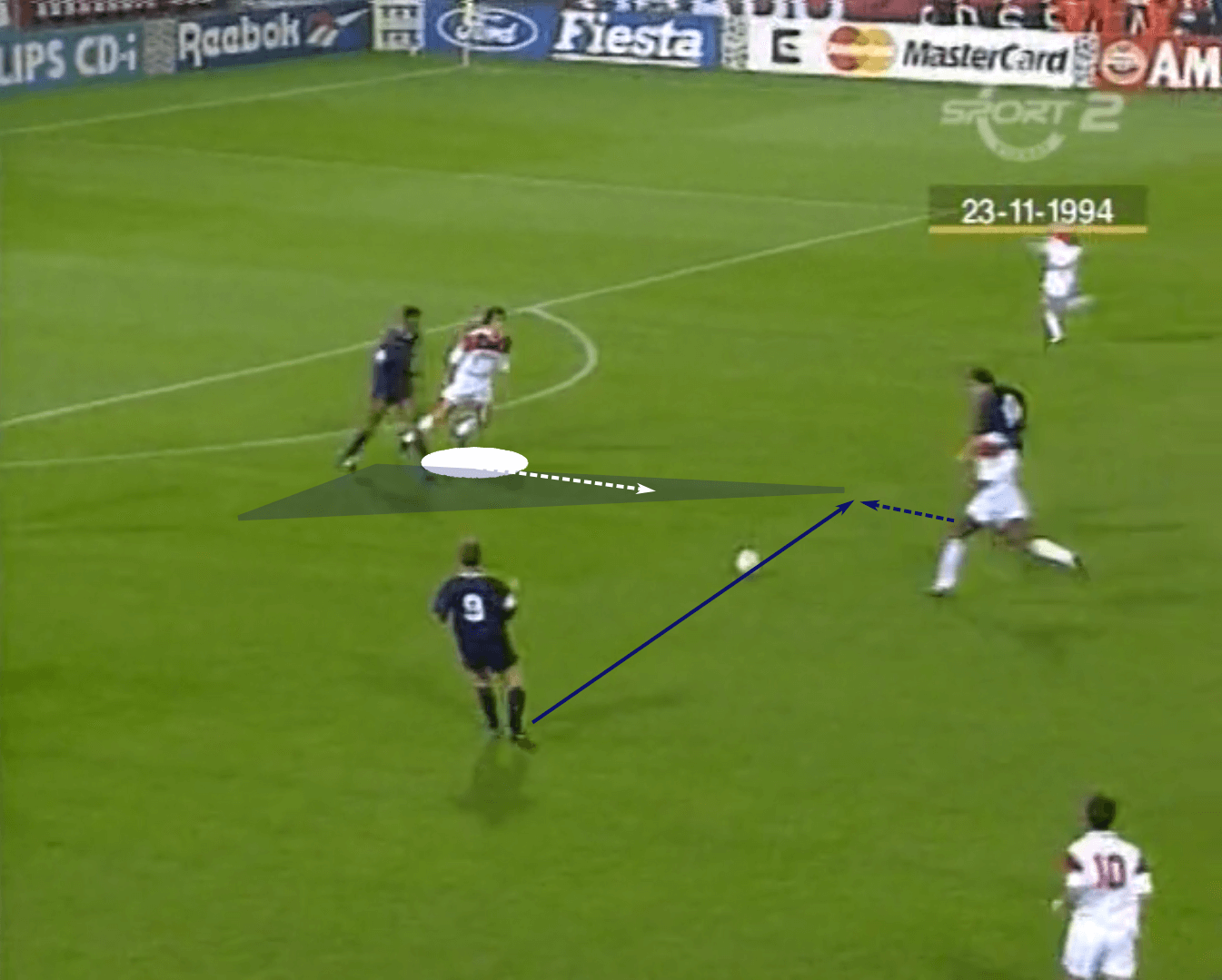
Rather than sitting back and bracing himself to defend in a numbers down scenario, Maldini’s aggression kicked into action.
His body orientation allowed him to quickly step forward and limit the passing angle to the high player.
Knowing his opponent would see the pressure and try to play forward with his first touch, Maldini quickly closed that space and then decelerated just before the pass was sent.
That deceleration allowed him to get into a balanced position and block the pass.
Danger averted.
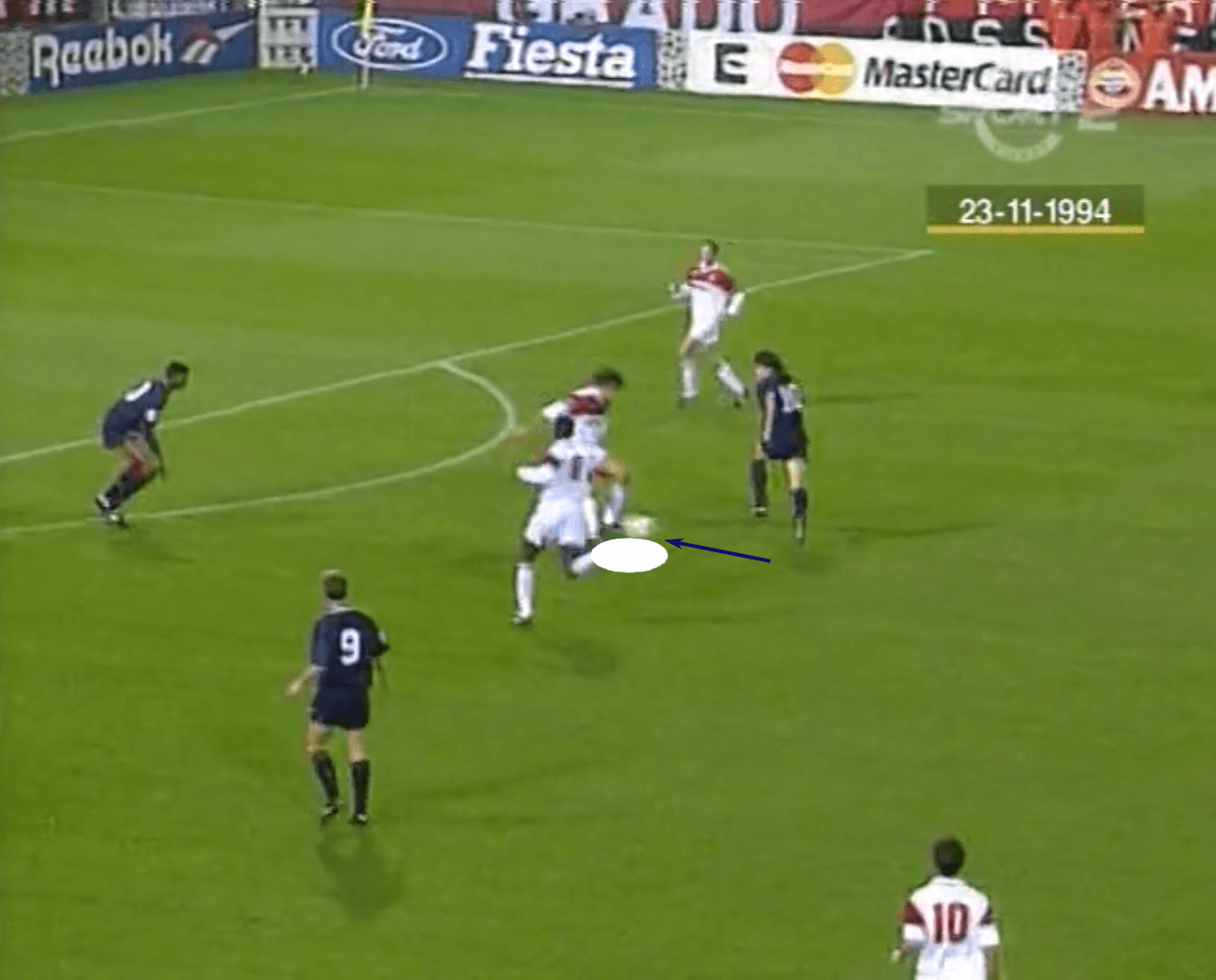
The stakes were high in that last example.
Had he not stopped the pass, Ajax would be in an ongoing 1v1 versus the keeper.
Our final example from this section highlights a lower risk scenario but with equally aggressive action.
#1 shows Maldini in tight connection with his backline.
They’ve closed off the middle of the pitch, effectively defending against Johan Cruyff’s Barcelona’s central overload.
As the ball deflects to the right, Maldini quickly steps into that space.
He can do so knowing that he has adequate coverage along the backline.
Quickly closing down forward passing lanes and decelerating as he arrived shifted momentum in his favour.
Not only had he cut off those forward passing lanes, but now he was prepared to get a foot to any pass or continue moving forward should his opponent attempt to dribble out of pressure.
The latter happened with his opponent turning to the right and heading in the direction of the wing.
Using his forward momentum, Maldini continued his aggressive pursuit up the pitch, knowing that his opponent had no way out.
He ended the play with an aggressive slide tackle.
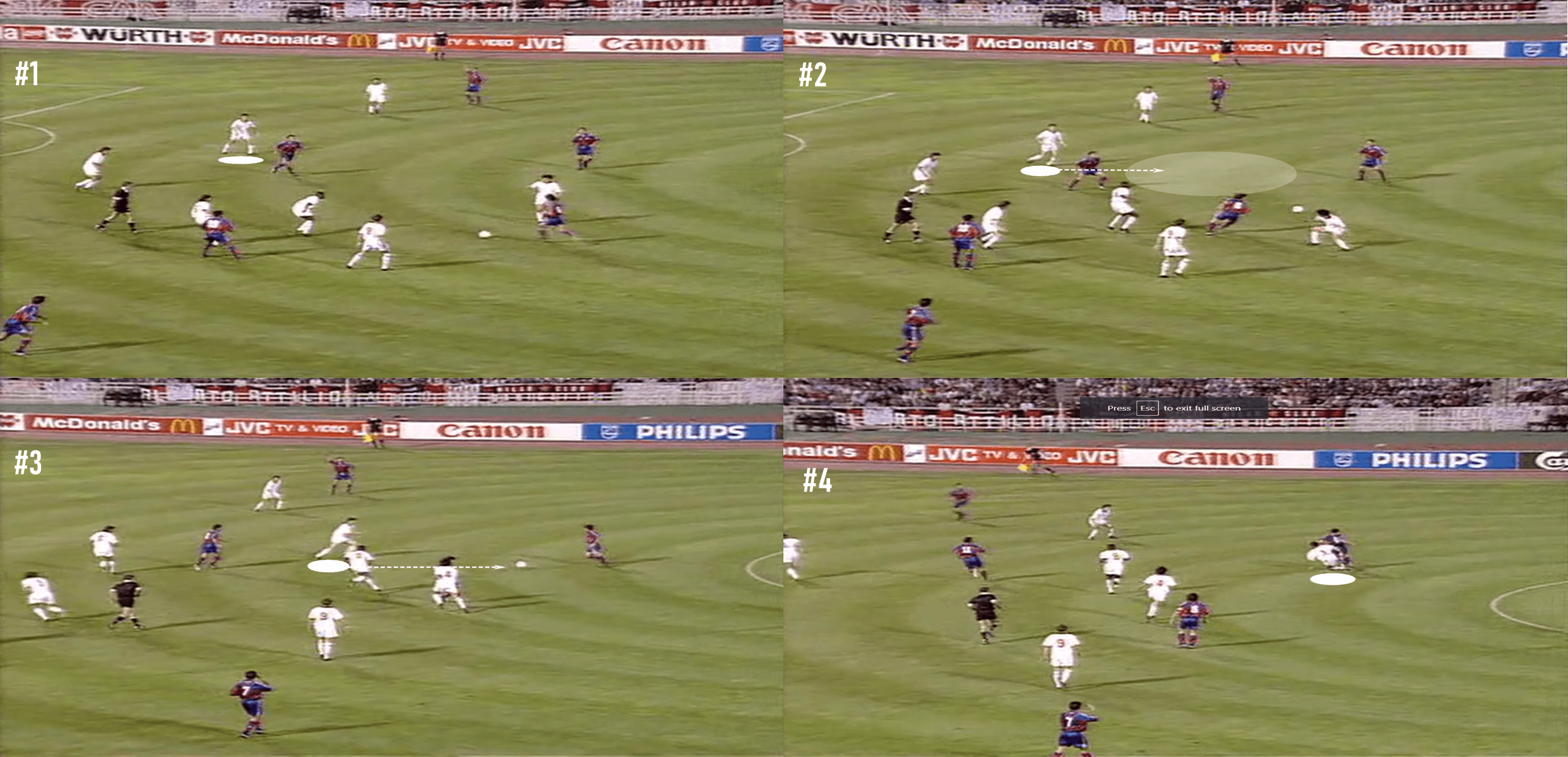
Maldini was an aggressive player who excelled when he could move forward to engage opponents.
This is a rarity in the game.
While most defenders prefer to keep playing in front of them, they rarely excel when the momentum carries them towards an opponent who’s also moving towards the oncoming pressure defender.
Typically, the balance of play favours the attacker because the defender’s momentum is moving in the wrong direction.
Not for Maldini.
Knowing that he excelled in the situations, he looked for opportunities to move forward and end attacks.
The key here is the anticipation of the ball reaching that central player.
Maldini’s excellent body orientation and field vision allowed him to see the playing field and identify the possibility of the ball skipping to the free man.
His quick movement up the field comes down to his body orientation.
He was ready to move forward from the start.
Then, as he approached, he knew that he had effectively cut out any forward passing options and had coverage behind him if his opponent should attempt to dribble.
He was looking for a change of direction away from Maldini.
Anticipating that action all the way, once he saw the visual cue he sprung into action and ended the Barcelona attack.
Paolo Maldini Timing
The last topic will address this timing.
Going to ground as often as he did, this is one area Maldini, as with all of his contemporaries, had to get right.
One poorly timed sliding tackle could see him sent off and potentially end his opponent’s career.
Though we won’t focus explicitly on sliding challenges, that is, in fact, where our first sequence ends.
But let’s set up the scenario.
Notice Maldini running with his opponent as Zinedine Zidane attempts to dribble through the Milan midfield.
He’s contested the entire way, so Maldini is looking for a heavy touch to trigger his movement forward.
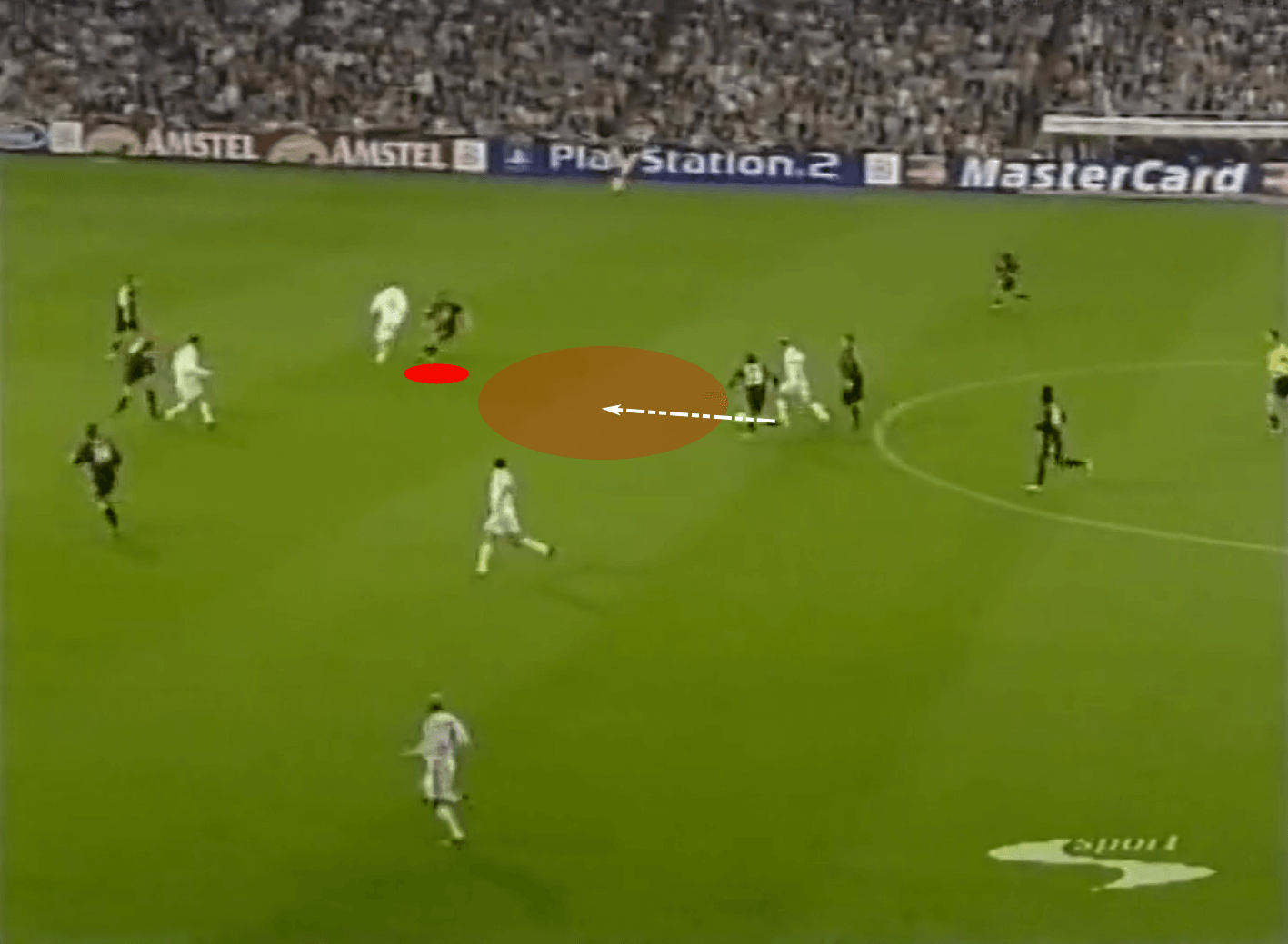
When that moment comes, Maldini springs into action, bursting forward to quickly close the gap and deny Zidane a clean touch on the ball.
While there is some coverage behind him, the stakes are fairly high for this challenge.
Should Maldini be beaten, he’ll leave his teammates in a difficult scenario.
Fortunately, he arrives just as Zidane does to ensure Zidane can’t poke the ball beyond him.
Maldini went into a wide sliding challenge, effectively blocking three to four feet of manicured grass.
He wins the challenge and has room to attack moving forward.
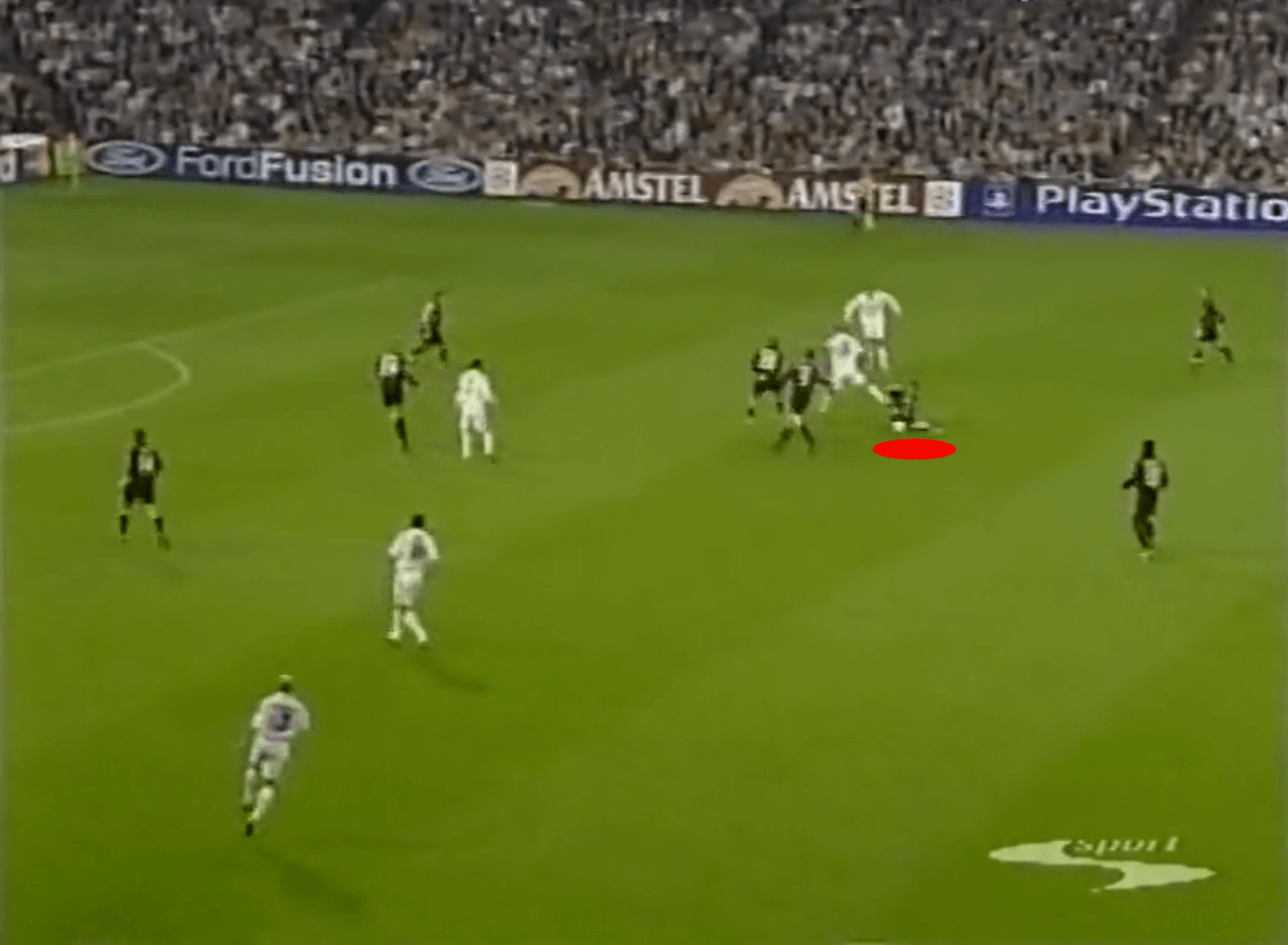
Timing his forward movement was the first key to success.
A step sooner and he gives Zidane the option of passing beyond him.
A step later and he’s late to his challenge, giving Zidane the space needed to poke the ball past Maldini and run at the final line of defenders.
Maldini’s forward movement was perfectly timed, but that does come back to the fact that his starting positioning, width and body orientation were excellent.
Knowing that he has covered depth and is well-positioned to challenge any pass to his mark, he can now shift his attention to those opportunities for forward movement.
By eliminating the threat of a pass in behind, he could then shift his attention to finding an opportunity to win a tackle.
When Maldini engaged in individual duels, he typically did so by quickly closing space, decelerating as he arrived, and intensely observing the opponent’s actions.
If you look to pass or shoot forward, the Italian was quick to set his feet and try to block the attempt.
Quickly closing down space allowed him to narrow the angle forward and increase the likelihood that he could get his foot to the ball, not leaving opponents with space to play over him or beyond his foot’s range of motion.
Should the opponent choose to dribble, Maldini was quick on his touch.
That’s exactly what we find in our final example.
As Figo received the pass, Maldini was quick to close him down.
Once the Portuguese Superstar cut inside, Maldini was quick to pursue.
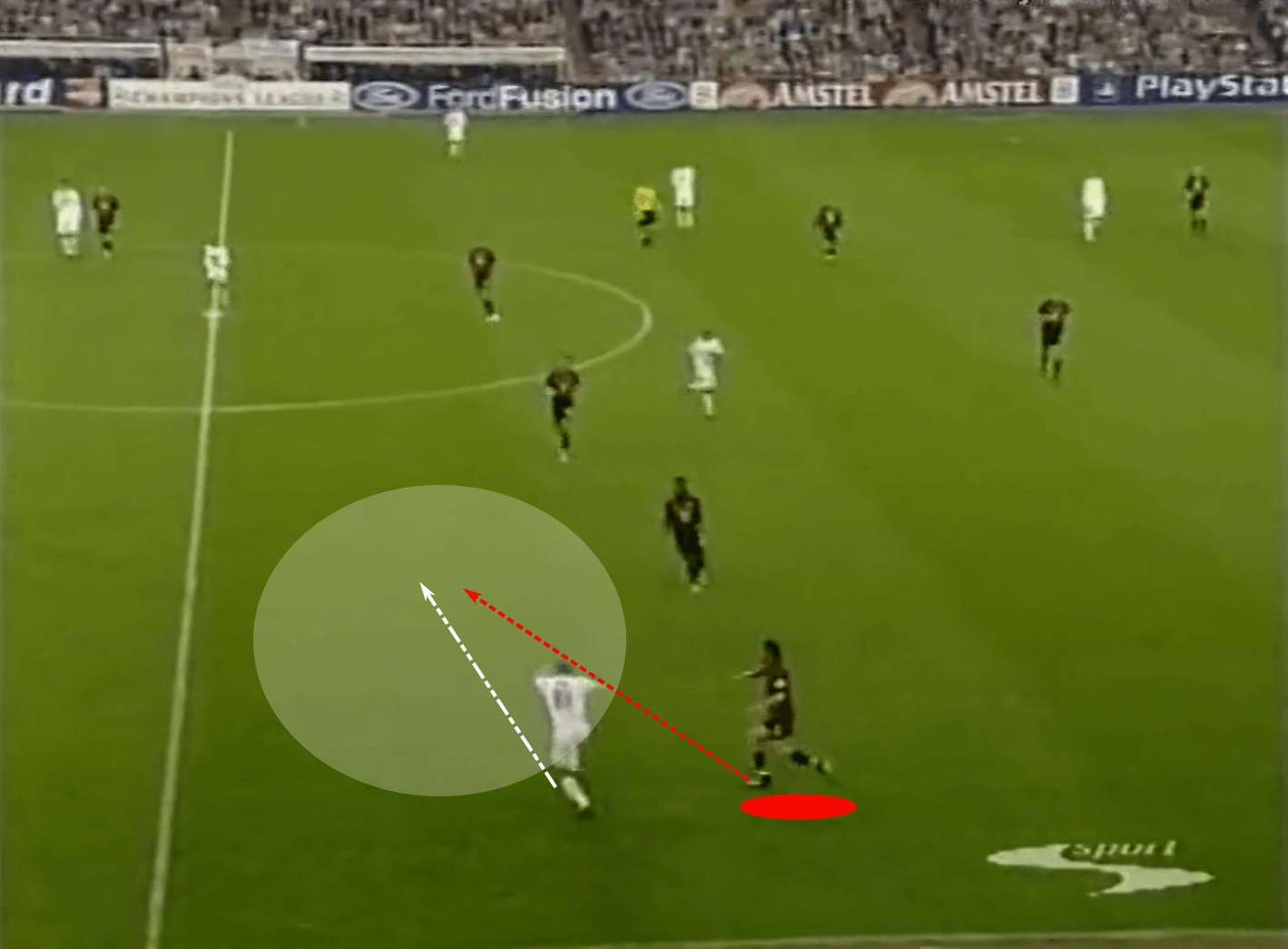
Only once the past was released did Maldini back off and recover to his position.
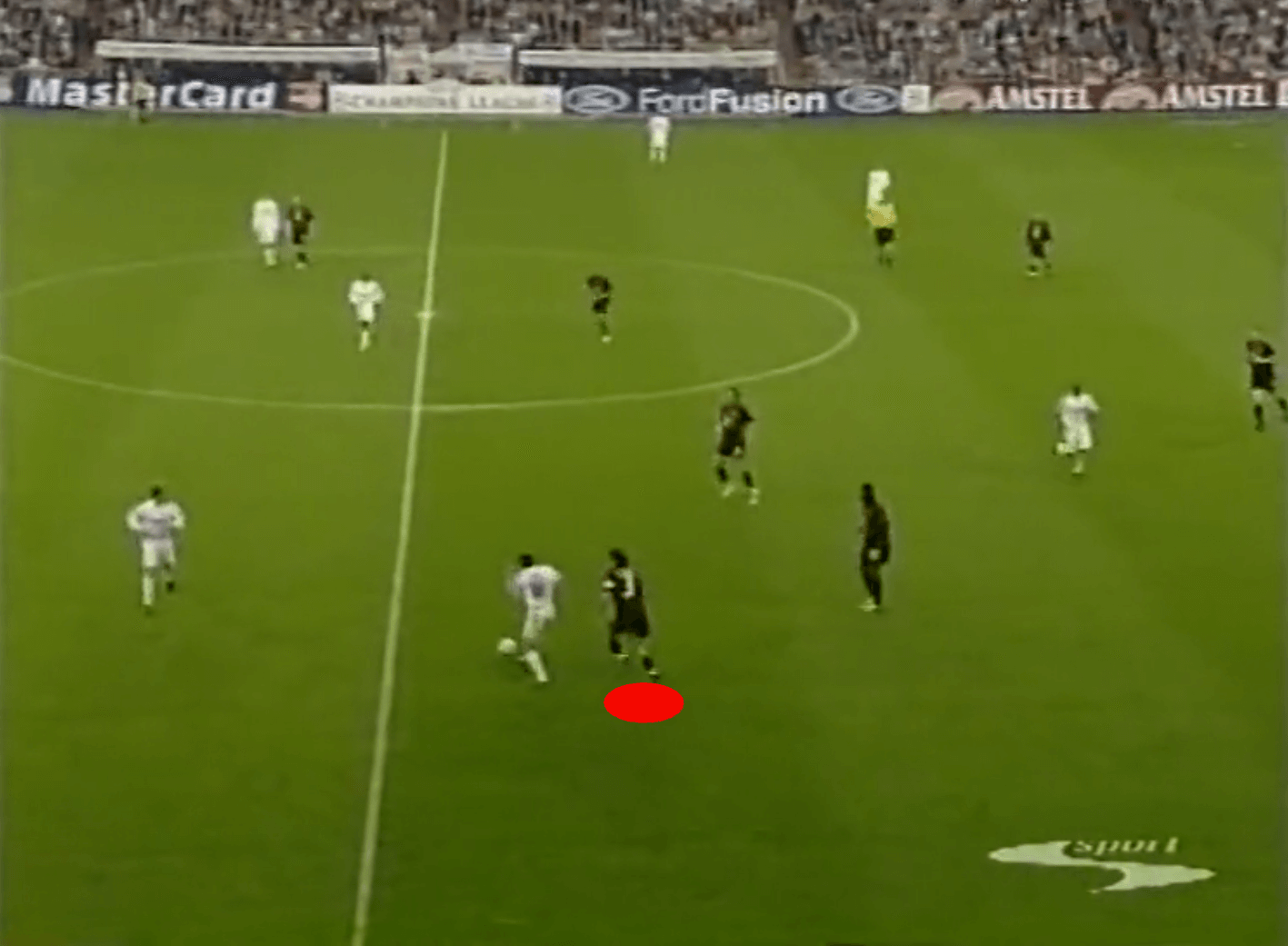
The two examples from this section show that it’s not enough to apply pressure on the opponent.
It has to be timed appropriately.
Arriving too early or too late, failing to decelerate or showing a lack of aggression as the attacker took a touch away from the defender often leads to positional superiorities for the attacking team.
When Maldini stepped into midfield, he did so to a) win the ball or b) deny progression.
We’ve seen his timing scattered throughout this analysis.
It gives a sense of his understanding of the game and helps us see why he fits into his side’s tactics either as a left-back or left centre-back.
He was highly adaptable, a footballing genius and acted on principles that were above and beyond the capabilities of most footballers.
Conclusion
Considered by many to be the greatest defender of all time, we’ve uncovered some of his key qualities.
Though he was a footballing genius, each of these core principles is transferable to our own environments.
Many of his matches are available online at no cost.
Watching him play gives you a sense of the intelligence and intensity of his playing style.
He was a man among men, a living legend even as he graced the pitch.
The lessons he offers are timeless.

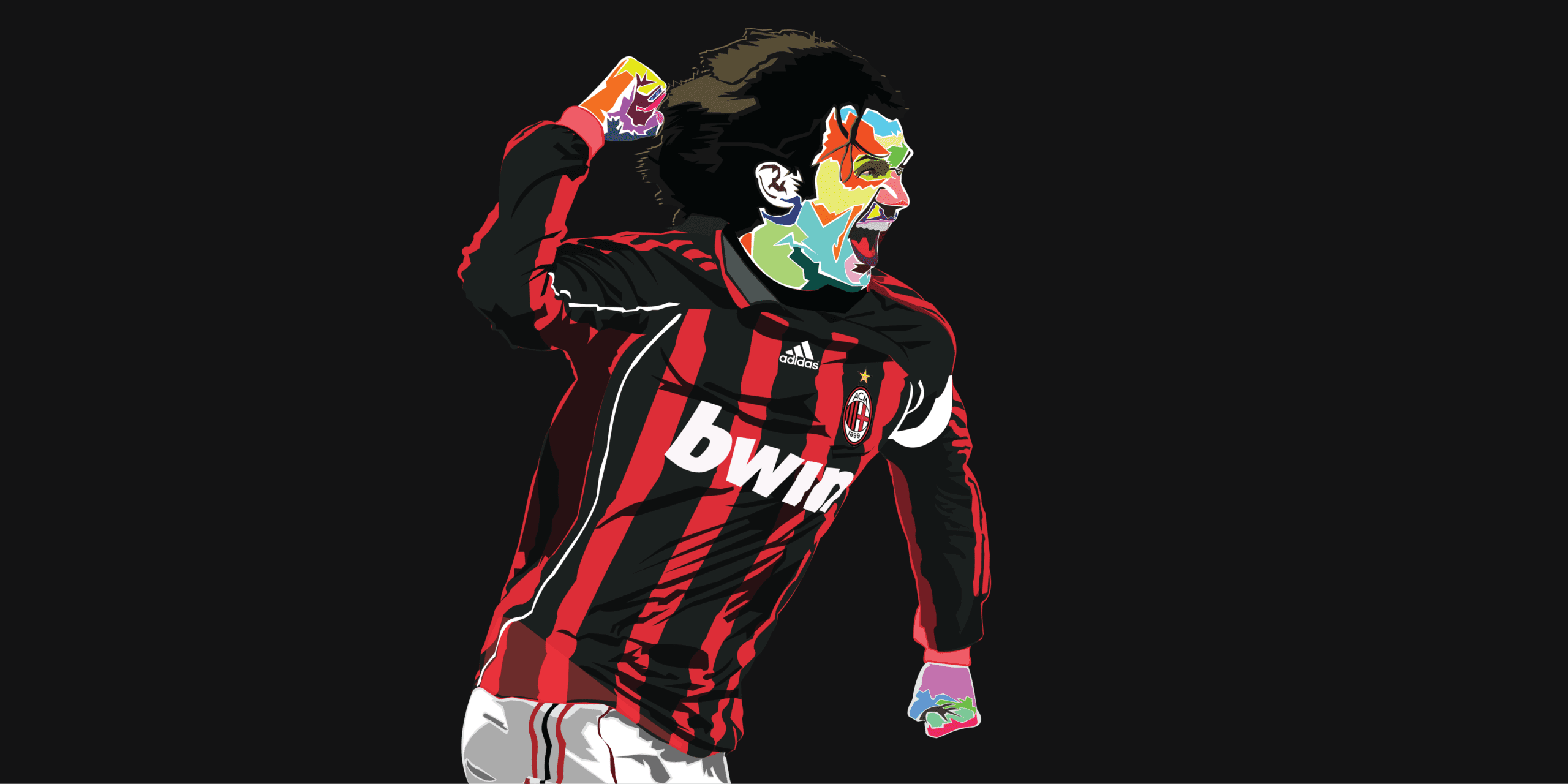



Comments